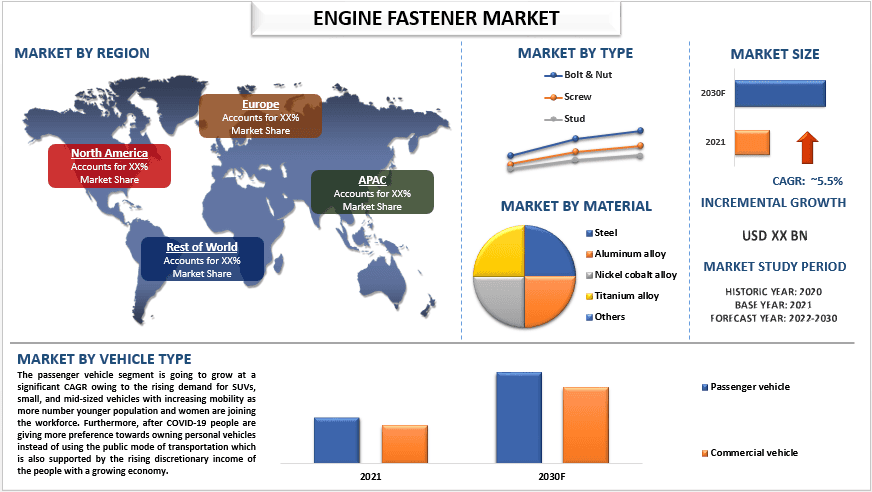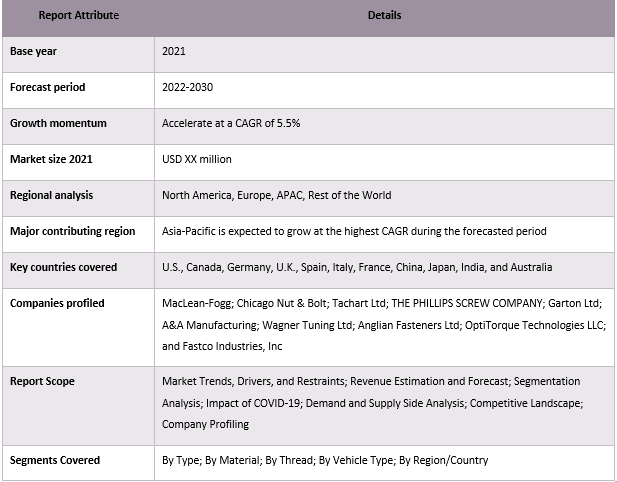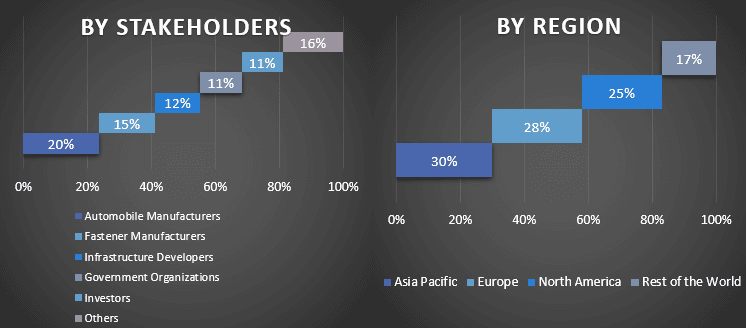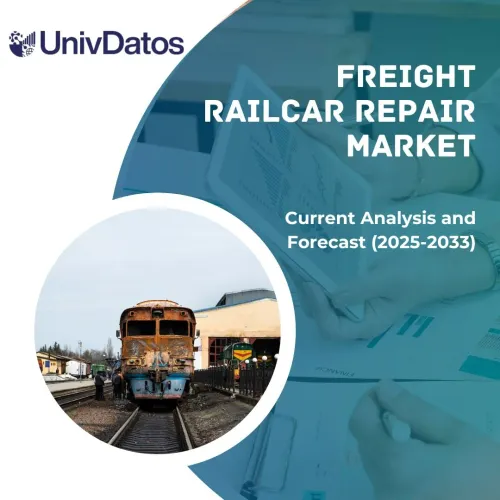- Trang chủ
- Về chúng tôi
- Ngành
- Dịch vụ
- Đọc
- Liên hệ với chúng tôi
Thị trường Ốc vít Động cơ: Phân tích và Dự báo Hiện tại (2022-2030)
Nhấn mạnh theo Loại (Bu-lông & Đai ốc, Vít, và Chốt), Vật liệu (Thép, Hợp kim Nhôm, Hợp kim Niken Coban, Hợp kim Titan, và Loại khác), Loại Ren (Ốc vít Ren cán và Ốc vít Ren cắt), Loại Xe (Xe Khách và Xe Thương mại), và Vùng/Quốc gia.

Thị trường ốc vít động cơ dự kiến sẽ tăng trưởng với tốc độ CAGR ổn định khoảng 5,5% trong giai đoạn dự báo.
Ốc vít là một công cụ được sử dụng để giữ các vật thể lại với nhau bằng cơ học, ốc vít thường tạo thành một khớp nối không vĩnh viễn, trong đó các thành phần có thể được tách ra mà không bị hư hỏng. Sức mạnh và độ tin cậy của một động cơ phụ thuộc rất nhiều vào chất lượng của ốc vít và trong sản xuất ô tô, điều rất quan trọng là phải đảm bảo rằng cụm bu-lông động cơ có khả năng hoạt động trong môi trường áp suất và ứng suất cao.
Tốc độ tăng trưởng của ngành công nghiệp ốc vít được quy trực tiếp cho sự tăng trưởng của lĩnh vực ô tô, trong đó khoảng 23% tổng số ốc vít được sản xuất trên toàn thế giới được tiêu thụ bởi ngành ô tô, chiếm thị phần cao nhất trong ngành và đang hoạt động có lợi cho ngành ốc vít do triển vọng tích cực của lĩnh vực ô tô do sự tăng vọt về nhu cầu trên tất cả các phân khúc, cho dù là xe khách hay xe thương mại. Sự tăng trưởng chủ yếu được thúc đẩy bởi thực tế là một lượng lớn nhu cầu bị dồn nén đang xuất hiện trên toàn bộ lĩnh vực sau COVID-19, nơi người tiêu dùng muốn sở hữu một chiếc xe cá nhân hơn là sử dụng phương tiện giao thông công cộng. Hơn nữa, nhu cầu về xe điện cũng đang tăng nhanh do nhận thức ngày càng tăng, trợ cấp từ chính phủ và lợi ích về chi phí khi sở hữu một chiếc xe điện. Ngoài ra, các nền kinh tế mới nổi đang tạo ra nhu cầu lớn về ô tô do thu nhập tăng, khả năng di chuyển tăng, đô thị hóa nhanh chóng và các hoạt động kinh tế gia tăng do đầu tư lớn vào cơ sở hạ tầng của chính phủ.Ví dụ, vào tháng 3 năm 2022, Nhật Bản trong một cuộc họp song phương với đối tác Ấn Độ đã thông báo rằng họ sẽ đầu tư 42 tỷ USD trong vòng 5 năm để hỗ trợ phát triển cơ sở hạ tầng đô thị của Ấn Độ và đường sắt cao tốc dựa trên công nghệ tàu cao tốc của mình.
Một số công ty lớn hoạt động trên thị trường bao gồm MacLean-Fogg; Chicago Nut & Bolt; Tachart Ltd; THE PHILLIPS SCREW COMPANY; Garton Ltd; A&A Manufacturing; Wagner Tuning Ltd; Anglian Fasteners Ltd; OptiTorque Technologies LLC; và Fastco Industries, Inc
Thông tin chi tiết được trình bày trong báo cáo
Dựa trên vật liệu, thị trường được phân chia thành thép, hợp kim nhôm, hợp kim niken coban, hợp kim titan và các loại khác. Trong số này, thép và hợp kim thép là vật liệu cho ốc vít chiếm thị phần đáng kể do thực tế là thép là vật liệu được sử dụng phổ biến nhất để sản xuất ốc vít do tính dễ uốn, độ bền kéo và độ bền cao. Ngoài ra, ốc vít thép tương đối kinh tế và rẻ để sản xuất, chúng cũng có khả năng chống ăn mòn cao, không bị giảm do biến dạng và sử dụng lâu dài.
“Châu Á Thái Bình Dương chiếm lĩnh thị trường ốc vít động cơ vào năm 2021.”
Thị trường ốc vít động cơ ở khu vực Châu Á Thái Bình Dương chiếm thị phần lớn nhất và dự kiến sẽ duy trì mức tăng trưởng trong suốt giai đoạn dự báo. Các quốc gia lớn ở Châu Á Thái Bình Dương như Ấn Độ, Trung Quốc, Việt Nam, Thái Lan, v.v. sẽ là thị trường lớn nhất cho ốc vít động cơ do tốc độ tăng trưởng kinh tế ngày càng tăng ở các quốc gia này, là một trong những nền kinh tế tăng trưởng nhanh nhất thế giới, thúc đẩy tiêu dùng với thu nhập ngày càng tăng và lĩnh vực ô tô đã được chứng minh là những người hưởng lợi lớn nhất từ các xu hướng này như đã xảy ra trong quá khứ ở các nước phát triển. Hơn nữa, Trung Quốc vẫn là thị trường ô tô lớn nhất thế giới, tiếp theo là Ấn Độ và các quốc gia Châu Á Thái Bình Dương khác do dân số đông và khả năng di chuyển tăng lên với lực lượng lao động đang gia tăng, do đó tạo ra nhu cầu lớn về ốc vít động cơ. Hơn nữa, việc chính phủ tăng cường chi tiêu cho việc phát triển cơ sở hạ tầng mới đã làm tăng tốc độ đô thị hóa, đây cũng là một động lực chính cho nhu cầu trong lĩnh vực ô tô.Ví dụ, vào tháng 2 năm 2023, chính phủ Ấn Độ đã trình bày một ngân sách, trong đó họ đã công bố tăng 37,4% chi tiêu vốn cho cơ sở hạ tầng lên 125 tỷ USD cho năm 2023-24.
Phạm vi Báo cáo Thị trường Ốc vít Động cơ

Lý do để mua báo cáo này:
- Nghiên cứu bao gồm phân tích về quy mô và dự báo thị trường được xác nhận bởi các chuyên gia chủ chốt trong ngành.
- Báo cáo trình bày một bản xem nhanh về hiệu quả hoạt động tổng thể của ngành.
- Báo cáo bao gồm phân tích chuyên sâu về các đối tác trong ngành nổi bật với trọng tâm chính là tài chính kinh doanh chính, danh mục sản phẩm, chiến lược mở rộng và sự phát triển gần đây.
- Kiểm tra chi tiết các động lực, hạn chế, xu hướng chính và cơ hội hiện có trong ngành.
- Nghiên cứu bao gồm toàn diện thị trường trên các phân khúc khác nhau.
- Phân tích cấp độ khu vực chuyên sâu của ngành.
Tùy chọn tùy chỉnh:
Thị trường ốc vít động cơ toàn cầu có thể được tùy chỉnh thêm theo yêu cầu hoặc bất kỳ phân khúc thị trường nào khác. Bên cạnh đó, UMI hiểu rằng bạn có thể có nhu cầu kinh doanh riêng, do đó, vui lòng kết nối với chúng tôi để có được một báo cáo hoàn toàn phù hợp với yêu cầu của bạn.
Mục lục
Phương pháp luận Nghiên cứu để Phân tích Thị trường Ốc vít Động cơ (2022-2030)
Phân tích thị trường lịch sử, ước tính thị trường hiện tại và dự báo thị trường tương lai của thị trường ốc vít động cơ toàn cầu là ba bước chính được thực hiện để tạo và phân tích việc áp dụng ốc vít động cơ ở các khu vực chính trên toàn cầu. Nghiên cứu thứ cấp chuyên sâu đã được tiến hành để thu thập các số liệu thị trường lịch sử và ước tính quy mô thị trường hiện tại. Thứ hai, để xác thực những hiểu biết sâu sắc này, nhiều phát hiện và giả định đã được xem xét. Hơn nữa, các cuộc phỏng vấn chính chuyên sâu cũng được thực hiện, với các chuyên gia trong ngành trên khắp chuỗi giá trị của thị trường ốc vít động cơ toàn cầu. Sau khi đưa ra giả định và xác nhận các số liệu thị trường thông qua các cuộc phỏng vấn chính, chúng tôi đã sử dụng phương pháp top-down/bottom-up để dự báo quy mô thị trường hoàn chỉnh. Sau đó, các phương pháp phân tích và tam giác dữ liệu thị trường đã được áp dụng để ước tính và phân tích quy mô thị trường của các phân khúc và phân khúc phụ của ngành. Phương pháp luận chi tiết được giải thích dưới đây:
Phân tích Quy mô Thị trường Lịch sử
Bước 1: Nghiên cứu chuyên sâu về các Nguồn thứ cấp:
Nghiên cứu thứ cấp chi tiết đã được tiến hành để có được quy mô thị trường lịch sử của thị trường ốc vít động cơ thông qua các nguồn nội bộ của công ty nhưbáo cáo thường niên & báo cáo tài chính, bản trình bày hiệu suất, thông cáo báo chí, v.v.,và các nguồn bên ngoài bao gồmtạp chí, tin tức & bài viết, ấn phẩm chính phủ, ấn phẩm đối thủ cạnh tranh, báo cáo ngành, cơ sở dữ liệu của bên thứ ba và các ấn phẩm đáng tin cậy khác.
Bước 2: Phân khúc Thị trường:
Sau khi có được quy mô thị trường lịch sử của thị trường ốc vít động cơ, chúng tôi đã tiến hành phân tích thứ cấp chi tiết để thu thập thông tin chi tiết về thị trường lịch sử và chia sẻ cho các phân khúc & phân khúc phụ khác nhau cho các khu vực chính. Các phân khúc chính được bao gồm trong báo cáo như loại, vật liệu, loại ren và loại xe. Phân tích cấp quốc gia hơn nữa đã được tiến hành để đánh giá việc áp dụng tổng thể các mô hình thử nghiệm trong khu vực đó.
Bước 3: Phân tích Yếu tố:
Sau khi có được quy mô thị trường lịch sử của các phân khúc và phân khúc phụ khác nhau, chúng tôi đã tiến hành một phân tích chi tiếtphân tích yếu tốđể ước tính quy mô thị trường hiện tại của thị trường ốc vít động cơ. Hơn nữa, chúng tôi đã tiến hành phân tích yếu tố bằng cách sử dụng các biến phụ thuộc và độc lập như loại, vật liệu, loại ren và loại xe của thị trường ốc vít động cơ. Một phân tích chuyên sâu đã được tiến hành cho các kịch bản cung và cầu có tính đến các quan hệ đối tác hàng đầu, sáp nhập và mua lại, mở rộng kinh doanh và ra mắt sản phẩm trong lĩnh vực thị trường ốc vít động cơ trên toàn cầu.
Ước tính & Dự báo Quy mô Thị trường Hiện tại
Xác định Quy mô Thị trường Hiện tại:Dựa trên những hiểu biết sâu sắc có thể hành động từ 3 bước trên, chúng tôi đã đưa ra quy mô thị trường hiện tại, những người chơi chính trên thị trường ốc vít động cơ toàn cầu và thị phần của các phân khúc. Tất cả các chia sẻ phần trăm cần thiết và phân tích thị trường đã được xác định bằng cách sử dụng phương pháp thứ cấp đã đề cập ở trên và đã được xác minh thông qua các cuộc phỏng vấn chính.
Ước tính & Dự báo:Để ước tính và dự báo thị trường, trọng số đã được gán cho các yếu tố khác nhau bao gồm động lực & xu hướng, hạn chế và cơ hội dành cho các bên liên quan. Sau khi phân tích các yếu tố này, các kỹ thuật dự báo có liên quan, tức là phương pháp top-down/bottom-up đã được áp dụng để đưa ra dự báo thị trường cho năm 2030 cho các phân khúc và phân khúc phụ khác nhau trên các thị trường lớn trên toàn cầu. Phương pháp nghiên cứu được áp dụng để ước tính quy mô thị trường bao gồm:
- Quy mô thị trường của ngành, về doanh thu (USD) và tỷ lệ áp dụng của thị trường ốc vít động cơ trên các thị trường lớn trong nước
- Tất cả các phần trăm chia sẻ, phân tích và phân tích các phân khúc và phân khúc phụ của thị trường
- Những người chơi chính trên thị trường ốc vít động cơ toàn cầu về các sản phẩm được cung cấp. Ngoài ra, các chiến lược tăng trưởng được các công ty này áp dụng để cạnh tranh trên thị trường đang phát triển nhanh chóng
Xác nhận Quy mô và Chia sẻ Thị trường
Nghiên cứu chính:Các cuộc phỏng vấn chuyên sâu đã được thực hiện với các Nhà lãnh đạo Ý kiến Chính (KOL) bao gồm các Giám đốc điều hành cấp cao (CXO/VPs, Trưởng phòng Kinh doanh, Trưởng phòng Marketing, Trưởng phòng Vận hành, Trưởng phòng Khu vực, Trưởng phòng Quốc gia, v.v.) trên khắp các khu vực chính. Các phát hiện nghiên cứu chính sau đó đã được tóm tắt và phân tích thống kê đã được thực hiện để chứng minh giả thuyết đã nêu. Các đầu vào từ nghiên cứu chính đã được hợp nhất với các phát hiện thứ cấp, do đó biến thông tin thành thông tin chi tiết có thể hành động.
Phân chia những người tham gia chính ở các khu vực khác nhau

Kỹ thuật Thị trường
Kỹ thuật tam giác dữ liệu đã được sử dụng để hoàn thành ước tính thị trường tổng thể và để đưa ra các con số thống kê chính xác cho từng phân khúc và phân khúc phụ của thị trường ốc vít động cơ toàn cầu. dữ liệu đã được chia thành một số phân khúc & phân khúc phụ sau khi nghiên cứu các thông số và xu hướng khác nhau trong các lĩnh vực loại, vật liệu, loại ren và loại xe trong thị trường ốc vít động cơ toàn cầu.
Mục tiêu chính của Nghiên cứu Thị trường Ốc vít Động cơ Toàn cầu
Các xu hướng thị trường hiện tại và tương lai của thị trường ốc vít động cơ toàn cầu đã được xác định trong nghiên cứu. Các nhà đầu tư có thể có được những hiểu biết chiến lược để đưa ra quyết định đầu tư dựa trên phân tích định tính và định lượng được thực hiện trong nghiên cứu. Xu hướng thị trường hiện tại và tương lai đã xác định sức hấp dẫn tổng thể của thị trường ở cấp độ khu vực, cung cấp một nền tảng cho người tham gia công nghiệp khai thác thị trường chưa được khai thác để hưởng lợi từ lợi thế đi đầu. Các mục tiêu định lượng khác của các nghiên cứu bao gồm:
- Phân tích quy mô thị trường hiện tại và dự báo của thị trường ốc vít động cơ tính theo giá trị (USD). Ngoài ra, phân tích quy mô thị trường hiện tại và dự báo của các phân khúc và phân khúc phụ khác nhau
- Các phân khúc trong nghiên cứu bao gồm các lĩnh vực loại, vật liệu, loại ren và loại xe.
- Định nghĩa và phân tích khuôn khổ pháp lý cho ngành ốc vít động cơ
- Phân tích chuỗi giá trị liên quan đến sự hiện diện của các trung gian khác nhau, cùng với việc phân tích hành vi của khách hàng và đối thủ cạnh tranh trong ngành
- Phân tích quy mô thị trường hiện tại và dự báo của thị trường ốc vít động cơ cho khu vực chính
- Các quốc gia chính của các khu vực được nghiên cứu trong báo cáo bao gồm Châu Á Thái Bình Dương, Châu Âu, Bắc Mỹ và Phần còn lại của thế giới
- Hồ sơ công ty của thị trường ốc vít động cơ và các chiến lược tăng trưởng được các đối tượng tham gia thị trường áp dụng để duy trì trong thị trường đang phát triển nhanh chóng
- Phân tích chuyên sâu cấp độ khu vực của ngành
Liên quan Báo cáo
Khách hàng đã mua mặt hàng này cũng đã mua










